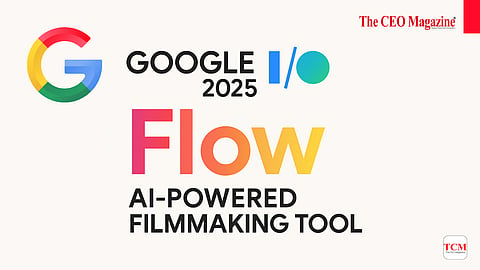
- News
- Women
- Magazine
- IndustryIndustry
- InsightsInsights
- Success Stories
- PublishPublish
- ContactContact
- Media KitMedia Kit

Google Flow
Google is bringing its generative AI prowess to the world of filmmaking with Flow, a new video generation platform unveiled at Google I/O 2025. Built for creatives, Flow promises to reshape how stories are told—offering filmmakers and video creators the ability to produce cinematic scenes using just text prompts, visual inputs, or a mix of both.
This launch signals more than just a product release. It marks a moment where AI steps into the director’s chair—not to take over, but to assist. Whether you're producing a short film, a branded content video, or an experimental art piece, Flow aims to make high-quality video creation faster, easier, and far more accessible.
Unlike generic video generation tools, Flow is custom-built with storytelling in mind. It combines three of Google’s most advanced models, Veo (for realistic video), Imagen (for high-quality image generation), and Gemini (for natural language understanding), into a single platform.
What makes Flow stand out is its seamless integration of these technologies. Users can generate a scene from a text description, build a shot around a visual reference, or use both. For example, a creator might describe a foggy city street at night, upload an image of a character’s face, and receive a consistent, cinematic clip that brings that world to life.
Flow isn’t just about generating standalone clips. It’s designed as a complete video creation workspace, where users can craft coherent sequences, manage visual consistency, and iterate quickly. At its core is a powerful editing tool called Scenebuilder, which allows users to expand, transition, and refine their scenes with fluid motion and continuity.
Another standout feature is Camera Controls, giving creators command over angles, motion paths, and visual perspective. This puts more of the artistic direction in the hands of the user, rather than relying solely on AI’s automatic choices.
Consistency across clips is also a key focus. Creators can reuse characters, objects, and environments—either by uploading reference assets or by generating them in-platform. Once created, these “ingredients” can be used throughout different parts of a video project, maintaining visual cohesion.
To help users explore what’s possible with the platform, Google introduced Flow TV—an in-app gallery showcasing videos made with Flow. Each featured clip includes the prompts and techniques used, giving users an inside look at how certain effects or styles were achieved.
This isn’t just for inspiration. It’s a practical resource for creators looking to learn by doing, offering a hands-on understanding of how different inputs produce different outputs.
Flow evolved from Google’s experimental VideoFX project, which laid the foundation for what is now a much more robust tool. With Flow, Google has moved from experimentation to execution, rolling out the platform as part of its AI Pro and AI Ultra plans in the U.S.
Subscribers to the AI Pro plan receive access to Flow’s key features along with 100 video generations per month. AI Ultra users get early access to Veo 3, which supports environmental sounds and character dialogue—bringing a new dimension of realism to AI-generated videos.
At its heart, Flow is about unlocking new ways to tell stories. Google emphasizes that this tool isn’t meant to replace human creativity—it’s designed to augment it. By simplifying complex production tasks and offering intuitive tools, Flow gives creators the space to focus on ideas, emotion, and narrative.
It’s also part of a larger trend: AI is no longer just a backend tool; it's becoming a co-creator. With the ability to generate cinematic shots from scratch and build coherent scenes at scale, Flow opens up opportunities for storytellers who may not have access to big crews or high-end equipment.
Whether used in film, advertising, education, or digital content creation, Flow offers a flexible and powerful new approach to video production.
While Flow is already making waves, Google acknowledges that this is just the beginning. The platform is still evolving, and more features and improvements are expected as it expands to more users and countries.
The future of Flow, and AI filmmaking more broadly will likely be shaped by how creators use these tools. Feedback from the community will help refine workflows, push the limits of what’s possible, and determine how AI fits into the creative process.
Flow is a glimpse into the future of storytelling. By combining the precision of advanced AI with the vision of human creators, Google is opening up new creative frontiers. As more people gain access and experiment with its capabilities, Flow could become a cornerstone of the next chapter in visual storytelling.
Follow us on Google News
